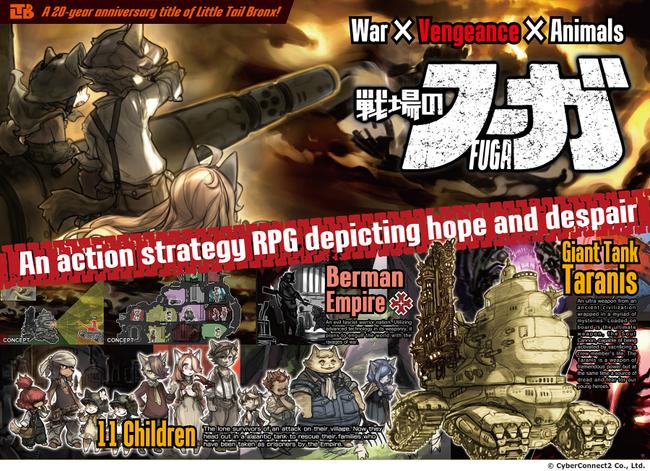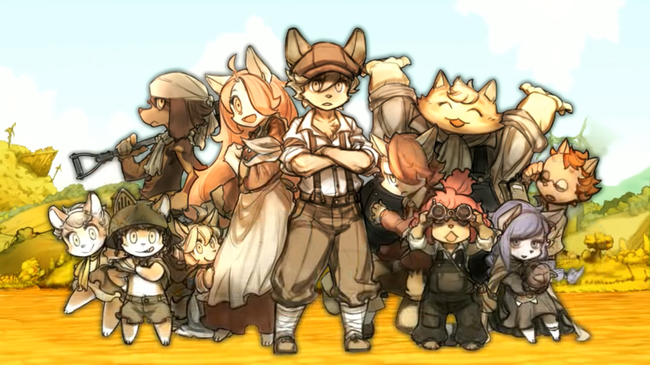
Fuga: Melodies of Steel Hands-On Impressions
During our interview with CyberConnect2, we asked them about the trials and tribulations of self-publishing your own games - a struggle that the company has been directly dealing with as of late, with the development of their self-proclaimed "Trilogy of Vengeance", a set of smaller multiplatform releases that the company intends to use as their introduction to self-publishing their own titles without the need of a separate publisher. Regardless of the precautions you make, however, striking it out on your own to make your own games is a challenge - whether you're an established company, or someone developing their very first title.
Sitting down to play Fuga: Melodies of Steel, I had a lot of thoughts running through my mind. I’m a big fan of the Little Tail Bronx series, for one – and I wasn’t sure how to feel about the heel turn that Fuga was making compared to the gameplay in both Tail Concerto and Solatorobo: Red the Hunter. Additionally, the overall tone of the game was notably darker compared to those two titles as well. While both had their somber moments, there’s a distinct difference between moments of sadness, and the entire plot revolving around essentially orphans fighting for their very lives. It’s a pretty wild departure from the series’ norm, to say the least.

As far as gameplay is concerned, Fuga is a turn-based RPG. CyberConnect2 is likening it as a tactical RPG, and there’s certainly some merit to that claim. Players delegate children to different functions for their trusty tank, Taranis – split between the machine guns, cannon, and heavy cannon, with up to 2 children per weapon. Each weapon runs on its own timer, so instead of choosing a weapon to use and then waiting for all of the enemies’ turns to rotate, you have to pay attention to when which weapon will be available again by looking at the top of the battle UI – much like in games like Trails in the Sky the battle order appears as a line that you can keep an eye on.
The demo that I played took me through what looks to be one chapter of the story – or at least a portion of one. It was broken up into various, randomized sections. With battles, random events that can either bolster or hinder my progress, and moments of respite where I was free to wander free throughout the tank, talking to the other children to complete various tasks to either gather materials, upgrade the tank, and strengthen the children’s bonds. Before sitting down at the demo I managed to catch a look at the people playing the demo just before me, and so I can confirm that even at this stage the demo does indeed randomize on each playthrough.
After the first battle in the game's first combat section, I was treated to a tutorial detailing skills. By default, the 3 different weapon classes have their own strengths and weaknesses. The machine gun can delay enemies, the cannon can weaken them, and the heavy cannon just does a lot of damage. In addition to the weapons’ base attributes, however, each child stationed at a weapon also has their own skills that they can bring to the table. One kid might be able to use a skill that will allow a weapon to attack multiple enemies at once – another can double the damage of an attack, while another can make a weapon deal damage to an enemy’s armor or delay them regardless of the weapon in use. These skills can only be used a certain number of times per encounter, but since each character unlocks multiple skills it’s a major consideration where each child will be stationed. Will you stack delay and multi-hit on the cannon, so you can start off a battle dealing armor damage to every enemy while earning some time for your other kids to prepare? Or will you bank on attempting to take out the strongest enemy in one hit with a double-damage stacked heavy cannon?

It’s a little early to say exactly how well the gameplay will stack up in the grand scheme of things, but at least right now it’s certainly very promising. One thing that I can say for sure, though, is that the game’s artstyle is making a great first impression. The demo was played on a Switch, and the stylized 3D models and CGs, are absolutely gorgeous – even in their present unfinished state. The enemy units, despite being weapons of war that are out to mercilessly kill our protagonists, have these cute little animal motifs scattered about that really helps them stand out. It was a little hard to make out the music at times, thanks to the crowded event hall, but the moments I did have the chance to listen to it sounded about on par with the rest of the series’, which is certainly a good thing.
I was already excited to see how Fuga would stack up, as CyberConnect2’s first self-published release, but especially after getting the chance to play it myself – I can’t wait to see how the full game will turn out. If nothing else, the demo has convinced me that the full game is something you should be looking out for.